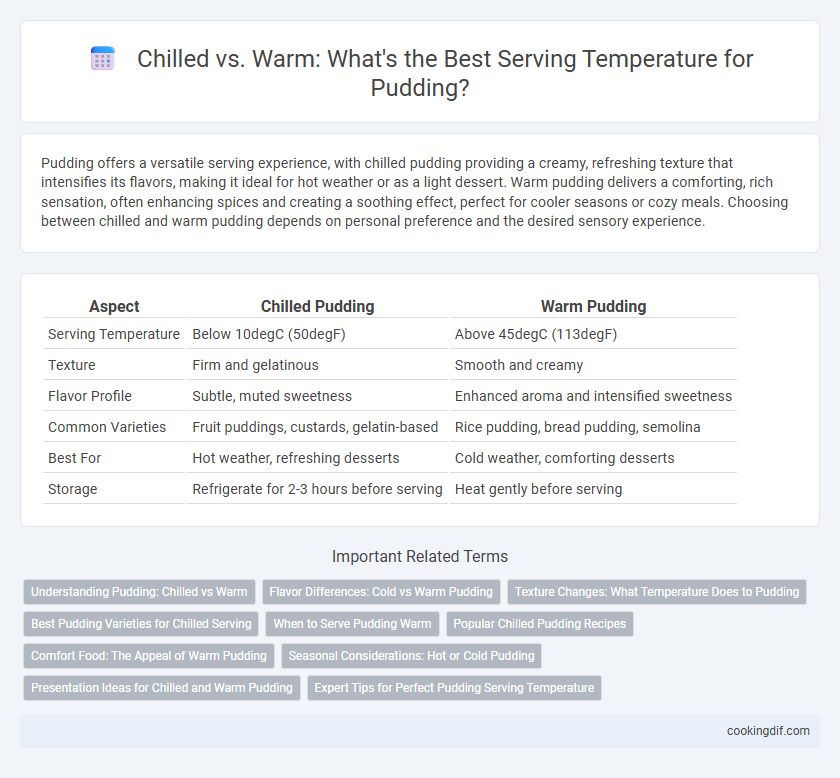Pudding offers a versatile serving experience, with chilled pudding providing a creamy, refreshing texture that intensifies its flavors, making it ideal for hot weather or as a light dessert. Warm pudding delivers a comforting, rich sensation, often enhancing spices and creating a soothing effect, perfect for cooler seasons or cozy meals. Choosing between chilled and warm pudding depends on personal preference and the desired sensory experience.
Table of Comparison
| Aspect | Chilled Pudding | Warm Pudding |
|---|---|---|
| Serving Temperature | Below 10degC (50degF) | Above 45degC (113degF) |
| Texture | Firm and gelatinous | Smooth and creamy |
| Flavor Profile | Subtle, muted sweetness | Enhanced aroma and intensified sweetness |
| Common Varieties | Fruit puddings, custards, gelatin-based | Rice pudding, bread pudding, semolina |
| Best For | Hot weather, refreshing desserts | Cold weather, comforting desserts |
| Storage | Refrigerate for 2-3 hours before serving | Heat gently before serving |
Understanding Pudding: Chilled vs Warm
Chilled pudding offers a creamy texture and refreshing taste, enhancing flavors like vanilla or chocolate, while warm pudding provides a comforting, silky experience ideal for indulgent desserts. The serving temperature significantly influences the mouthfeel and overall enjoyment, with chilled pudding firming up and warm pudding becoming smoother and more aromatic. Selecting between chilled and warm depends on the type of pudding and desired sensory experience, from cold, set custards to hot, freshly prepared rice or bread puddings.
Flavor Differences: Cold vs Warm Pudding
Chilled pudding offers a denser, creamier texture that enhances the subtle sweetness and highlights ingredients like vanilla or chocolate. Warm pudding delivers a softer, more comforting mouthfeel, intensifying flavors such as caramel or spices by releasing aromatic oils. Serving temperature significantly influences the perception of sweetness and richness, making cold pudding taste more refreshing while warm pudding feels more indulgent.
Texture Changes: What Temperature Does to Pudding
Chilling pudding firms its creamy texture, creating a dense and smooth consistency that enhances mouthfeel and flavor concentration. Warm pudding offers a softer, silkier texture as heat loosens the starch network, resulting in a more fluid and comforting experience. Serving temperature significantly affects pudding's structure, with cold temperatures promoting thickness and warm temperatures encouraging a velvety, spoonable quality.
Best Pudding Varieties for Chilled Serving
Best pudding varieties for chilled serving include classic vanilla, chocolate mousse, and fruit-based puddings like mango or strawberry. These puddings maintain a smooth, creamy texture and refreshing taste when served cold, enhancing their rich flavors and making them ideal for warm weather. Chilled puddings also offer a firmer consistency compared to warm servings, which is perfect for layered or decorative dessert presentations.
When to Serve Pudding Warm
Serving pudding warm enhances the flavors and creates a comforting dessert experience, especially with rich varieties like chocolate or bread pudding. Warm pudding is ideal immediately after cooking, when the texture is smooth and creamy, allowing the custard to remain soft and inviting. This serving temperature is perfect for cozy settings or seasonal occasions such as autumn and winter, where warmth provides a satisfying contrast to colder weather.
Popular Chilled Pudding Recipes
Chilled pudding recipes are favored for their smooth, creamy texture and refreshing taste, making them ideal for warm weather desserts like classic vanilla or chocolate pudding. Popular chilled puddings include layered trifles, panna cotta, and fruit-infused custards, which benefit from refrigeration to enhance flavor and consistency. Serving pudding cold intensifies its richness and allows flavors to meld, whereas warm pudding varieties like bread pudding are more comforting but less vibrant in aroma.
Comfort Food: The Appeal of Warm Pudding
Warm pudding enhances the comforting qualities of this classic dessert by releasing rich aromas and delivering a velvety texture that soothes the senses. Serving pudding warm maximizes its indulgent appeal, making it an ideal comfort food during colder months or after a long day. The gentle heat also intensifies flavors like vanilla, chocolate, and cinnamon, reinforcing the nostalgic and satisfying experience.
Seasonal Considerations: Hot or Cold Pudding
Serving pudding chilled enhances its refreshing qualities, making it ideal for warm weather and summer months when a cool dessert satisfies heat-induced cravings. Warm pudding delivers comfort and richness, perfectly suited for colder seasons or cozy indoor settings where heat and texture contribute to a soothing experience. Seasonal considerations influence whether to serve pudding hot or cold, aligning the dessert's temperature with ambient climate and consumer preference for optimal enjoyment.
Presentation Ideas for Chilled and Warm Pudding
Chilled pudding offers a smooth, firm texture perfect for elegant layered desserts and can be beautifully garnished with fresh berries or mint leaves for vibrant presentation. Warm pudding creates a comforting, creamy appeal that pairs well with a drizzle of caramel sauce or a scoop of vanilla ice cream to enhance visual and flavor contrast. Both serving temperatures allow for creative plating designs like ramekins, glass jars, or decorative bowls that elevate the overall dessert experience.
Expert Tips for Perfect Pudding Serving Temperature
Expert tips for serving pudding emphasize that chilled pudding enhances texture and flavor clarity, especially for custard-based varieties, by allowing the dessert to set firmly and the ingredients to meld. Warm pudding is ideal for comfort desserts like bread pudding or rice pudding, maintaining a creamy consistency and intensifying spices or vanilla aromas. For perfect serving temperature, aim for chilling pudding between 4-7degC (39-45degF) and warming servings to approximately 40-50degC (104-122degF) to optimize taste and mouthfeel.
chilled vs warm for pudding serving temperature Infographic

 cookingdif.com
cookingdif.com